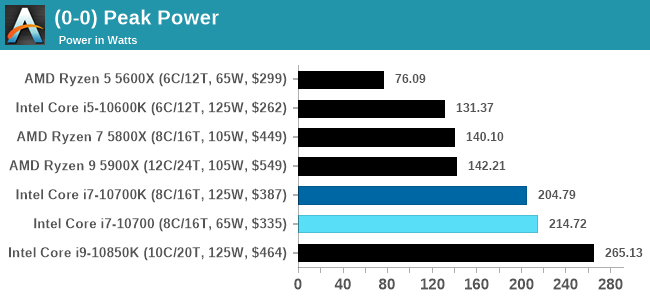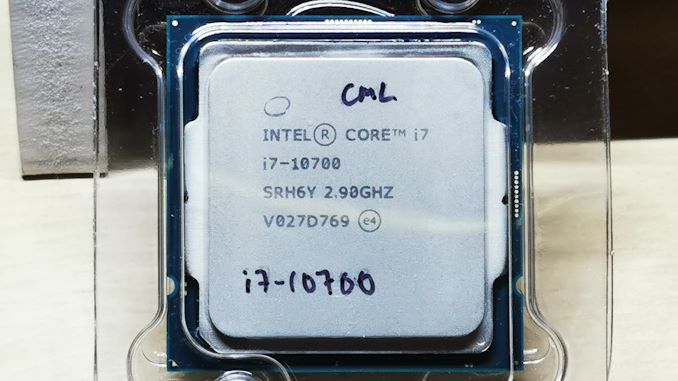Intel Core i7-10700 vs Core i7-10700K Review: Is 65W Comet Lake an Option?
by Dr. Ian Cutress on January 21, 2021 10:30 AM EST- Posted in
- CPUs
- Intel
- Core i7
- Z490
- 10th Gen Core
- Comet Lake
- i7-10700K
- i7-10700
Conclusion: TDP is Not Fit For Purpose
In years gone by, processors were sold with a single frequency and power rating. It was very quickly realized that if a processor could effectively go to sleep, using either lower voltage or lower frequency (or both) then a lot of idle power could be saved. Going the other way, processor designers realized that for temporary short bursts, a core could run at a higher frequency before it reached a thermal limit. Also, using a multi-core processor meant that either the power budget could be shared across all the cores, or it could be focused in one.
Both AMD and Intel have noticed this over time, and both companies have different attitudes on how they report numbers relating to ‘base frequency’ and related power as well as the bursty ‘turbo frequency’ and related power. Out of those four metrics, the only one Intel doesn’t provide is turbo power, because from their perspective it is system dependent.

Intel lets motherboard manufacturers determine how long a system can turbo for, and what that budget is. Intel encourages motherboard manufacturers to over-engineer the motherboards, not only for overclocking, but for non-overclockable CPUs to get the best performance for longer. This really messes up what the ‘default out-of-the-box performance’ should be if different motherboards give different values. The trend lately is that enthusiast motherboards enable an unlimited turbo budget, and the user building their system just has to deal with it.
This means that users who buy the Core i7-10700 in this review, despite the 65 W rating on the box, will have to cater for a system that will not only peak around 215 W, but sustain that 215 W during any extended high-performance load, such as rendering or compute. We really wished Intel put this 215 W value on the box to help end-users determine their cooling, as without sufficient guidance, users could be hitting thermal limits without even knowing why. At this point, 'Intel Recommended Values' for turbo time and budget mean nothing outside of Intel's own OEM partners building commercial systems.
Core i7-10700 vs Core i7-10700K Performance
In the review we highlighted that these two processors have a peak turbo frequency difference of 300 MHz and an all-core turbo frequency difference of 100 MHz. The fact that one is rated at 65 W and the other is rated at 125 W is inconsequential here, given that most end-user motherboards will simply enable turbo all the time. This means the performance in most of our tests between the two is practically identical, and consummate to a 100-300 MHz frequency difference.
In practically all of our tests, the Core i7-10700K is ahead by a super slim margin. At $387 for the 10700K compared to $335 for the 10700, the performance difference is not enough to warrant the $52 price difference between the two. Performance per dollar sides mostly with the Core i7-10700, although users getting the i7-10700K will likely look towards overclocking their processor to get the most out of it – that ultimately is what to pay for.
The other comparison point is with the Ryzen 5 5600X, which has two fewer cores but costs $299. In practically every test, the increased IPC of the Ryzen over Intel means that it sits identical with the Core i7 processors, AMD is cheaper on list price, and at a much lower power (AMD will peak around 76 W, compared to 215 W). AM4 motherboards are also abundant, while corresponding Intel motherboards are still expensive. The problem here however is that AMD is having such high demand for its product lines right now that finding one in stock might be difficult, and it probably won’t be at its recommended price.
Users in this price bracket have a tough choice – the more efficient AMD processor that might be in stock, compared to the Intel processor that will be in stock but more cooling will likely be required.











210 Comments
View All Comments
Samus - Friday, January 22, 2021 - link
I don't think ANYONE actually wants to see the numbers for these chips at 65W :)Spunjji - Monday, January 25, 2021 - link
I love a good laugh!iAPX - Saturday, January 23, 2021 - link
I totally agree, a 5600X and a 10700 on their 65W TDP, and their maximum performance, to gives a baseline of what performance-level is WARRANTED by their makers.etal2 - Thursday, January 21, 2021 - link
Setting the limits in the bios is very nice and all but without the voltage regulation and thermal capacity they can not sustain this performance for very long regardless of the numbers set.I very much doubt that on the 60$ cheap 4 phase vrm boards the manufacturers set the limits very high, they will get fried boards within the warranty period and we know very well they can't have that.
Spunjji - Friday, January 22, 2021 - link
That would be nice to see. Perhaps an article showing which of a representative selection of processors provide the best performance at a given set of fairly common power levels (65W / 95W / 125W).Something for when Dr Cutress finds himself with infinite time and no impending deadlines 😅
u.of.ipod - Thursday, January 21, 2021 - link
So happy I waited patiently and got a Ryzen 5600x for my small form factor system. The fact it can hang with the i7's and only consumes 1/3 the peak power draw is great for heat output and playing nicely with SFX PSUs.Golgatha777 - Thursday, January 21, 2021 - link
And that's how you end up with graphs like this one.https://cdn.mos.cms.futurecdn.net/i9W8M8HgGaTqRs4b...
Spunjji - Friday, January 22, 2021 - link
Oof.Samus - Friday, January 22, 2021 - link
Oof.magreen - Friday, January 22, 2021 - link
Pentium 4 Extreme Edition all over again